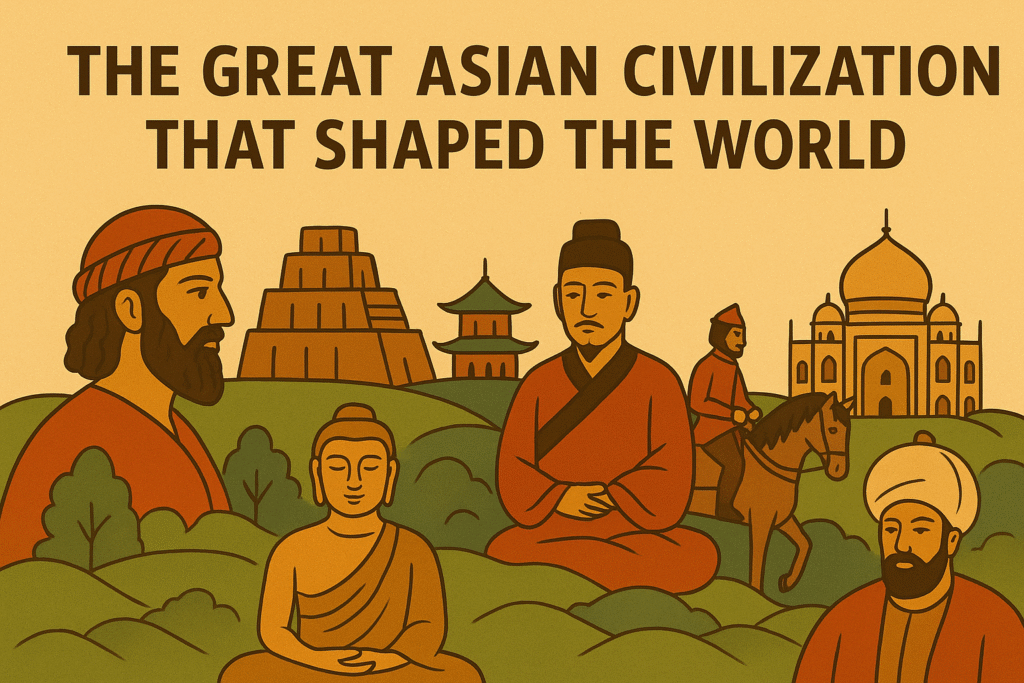Asia’s the largest continent out there. You know, it’s hosted some of the biggest civilizations in history. Back from ancient days right up to medieval times, these places in Asia started cultures and empires. They influenced politics, religion, science. Even the way we think now comes from them. In this piece, we’re gonna look at a few of these key Asian civilizations. And see how they really changed things for good.
Mesopotamia – The Cradle of Civilization
People argue sometimes if Mesopotamia counts more as Middle East or Asia. But it’s often labeled the cradle of civilization anyway. It sat between the Tigris and Euphrates rivers. That’s in today’s Iraq and nearby spots. Folks there came up with writing, like cuneiform. They invented the wheel too. And the first legal codes, such as Hammurabi’s Code.
This wasn’t just about getting by day to day. They built systems that affect us still. Farming techniques started here. City planning too. Government setups as well. Over the years, kingdoms in Mesopotamia got taken over by invaders. But those innovations kept going through history. I mean, they really stuck around.
The Indus Valley Civilization – Masters of Urban Life
Then there’s the Indus Valley civilization. It was another early one in Asia. Located in modern Pakistan and northwest India. It thrived around 2500 BCE. What stands out is their urban planning. Cities like Mohenjo-Daro and Harappa had straight streets. Advanced drainage systems. Public baths even.
Historians can’t read their script fully yet. So there’s plenty we don’t know about them. Still, the size of those cities shows an organized society. Pretty impressive. Unfortunately, it all faded around 1900 BCE. Probably from climate changes or rivers shifting. Like, things just changed up.
Ancient China – Dynasties and Inventions
China’s one of those civilizations that lasted forever, basically. The Shang and Zhou dynasties set the early groundwork. But the Han Dynasty, from 206 BCE to 220 CE, is when things really took off. Confucian ideas shaped society there. And they invented paper during that time.
Later on, dynasties like Tang and Song pushed art forward. Poetry too. Printing came about. Gunpowder as well. The Great Wall got built over centuries. It’s a symbol of Chinese power even now. So many modern tech and philosophies trace back to those ancient Chinese ideas. You know, roots run deep.
Ancient India – Knowledge and Spirituality
India didn’t just give the world spices or trade stuff. It offered deep philosophies and religions. Ones that guide billions still. Hinduism started there. Buddhism too. They spread across Asia and further.
Under the Maurya Empire, Ashoka helped Buddhism go wide. The Gupta Empire, around 320 to 550 CE, was like a golden age. Math advanced with the concept of zero and decimals. Astronomy grew. Classical Sanskrit literature bloomed. Those ideas made their way to the Islamic world later. And to Europe. Influencing science and learning everywhere.
The Mongol Empire – Connecting Continents
The Mongols get a bad rap sometimes for brutal conquests. But under Genghis Khan, they built the biggest land empire ever. It stretched from China to Europe. That made trade, culture, ideas flow across huge distances.
They protected the Silk Road during their rule. Merchants, travelers, scholars could share goods and knowledge. This linking up helped spark the Renaissance in Europe down the line. The empire split into smaller khanates eventually. But its effects were felt all over the world. Oh and, connections like that last.
The Ottoman Empire – East Meets West
The Ottoman Empire was based in what’s now Turkey. But it spread across Asia too. Lasted from late 13th century to the 20th. It bridged Asia and Europe. Controlled trade routes. Influenced art, architecture, governance.
They took in diverse cultures and religions. Though conflicts happened a lot. Decline hit with European powers rising. And modern nation-states forming. Still, their impact on Asian and world history stays strong. You know, it’s there.
Conclusion
From Mesopotamia to the Ottomans, these Asian civilizations laid the groundwork for our modern world. They came up with writing. Set up law systems. Spread religions. Pushed science ahead. Connected far-off cultures. Even if many fell apart, their legacies live on in languages, beliefs, knowledge.
Asia’s story is humanity’s story, really. How we learned things. Built stuff. Fought. Dreamed big. That’s why looking into these civilizations isn’t just past tense. It’s about getting who we are now.


